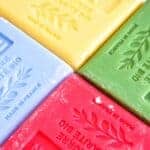For those making soap from scratch, soap making is a fun craft. If you have great attention to detail & the know-how to carefully follow directions, you can easily master soap making craft. Homemade soap making is an absolute pleasure to make, and once you learn making hand made soaps, you'll never go back to commercial soap. It's a really interesting craft that you can even begin experimenting with your homemade recipes now!

Lye is essential for a chemical reaction to produce organic soap. You have to be extraordinarily cautious about using lye as it is a corrosive substance. If lye is not used with proper precautions, it can bring burns, injury, and scarring. Luckily, there are ways for beginner crafters to use lye effectively and safely. Additionally, you can use different molds to create the finished product to make themed soap that meets your preferences.
Natural Hand made Soaps:
Natural hand made soaps are made using a variety of natural sources. Butters rich in nutrients, plant-based oils, antioxidants, and vitamins are natural sources used in hand made soaps. Your hair, body, and dry skin will love all these natural ingredients. Natural soaps are much better for the environment than soaps made with synthetic materials. Most soaps are washed off with water, and that water goes down the drain carrying the soap's ingredients along with it.
Alkali In Hand Made Soaps:
Natural homemade soap is a combination of alkali and natural fats. Alkali is also known as sodium hydroxide, which comes out of salt. Normal soaps do not contain alkali or natural fat. Nowadays, soaps are cleansers or synthetic detergents.
Hand Made Soaps Are Best For Skincare:
Hand made soaps are best for skin care as these soaps contain glycerin, a natural byproduct of the soapmaking process. Glycerin is an excellent moisturizer, and it is an emollient that attracts moisture from the air maintaining moisture in the skin overall the day.
Natural soap retains all the moisturizing natural glycerin. A rich, luxurious lather also forms with the help of natural glycerin. Superfatting, natural saponification, and skincare ingredients create a bar soap full of natural oils, glycerin, and moisturization. Handcrafted soap feeds your skin as your skin needs fatty acids to stay healthy. Natural hand made soaps are chemical-free and help in skin problems like eczema, psoriasis, and acne.
Hand Made Soaps Vs. Store-bought Soaps:
Commercial soap usually scents chemicals, while natural hand made soaps use natural essential oil. Natural soap preserves natural oils like coconut oil, shea butter, and other natural skin-nourishing oils. Natural oils in hand made soaps bars to protect and heal skin naturally. Hand made soaps bars are natural materials like oats, honey, goat milk, or plant-based oils.
Goat milk soap is a light chemical in unsaturated fats that can support a solid skin hindrance to keep skin sustained and saturated. Besides, goat milk soap is a high lactic corrosive substance that might assist with peeling the skin, which might help those with skin inflammation.
Detergents are made up of synthetic surfactants, cleaning agents, or petrochemicals. Hand made soaps bars are soaps in pure form, cleanses, and moisturizes your skin naturally. Natural soap is far more expensive than most commercial soap because of its natural ingredients.

Faster Melting Of Soap:
The soap, which contains a higher percentage of soothing oils like sunflower oil or olive oil, melts faster. The reason for fast melting could be not drying in between each use. If you want to avoid fast-melting, you must dry the soap between uses. Always place your soap in a dry, away from sunlight, or at a moisture-free place to avoid fast melting.
Tips to Make Your Soap Last Longer:
Following are some easy instructions to help your soap last longer:
- Use a washcloth instead of your hands.
- Use a soap saver.
- Choose a harder soap.
- Place your soap in an appropriate soap dish that allows water drainage.
- Let the soap air dry all the time completely.
Fragrance Sensitivity In Soaps:
Soaps with scents contain harsh preservatives and chemicals that can leave your skin itchy, red, and inflamed. No matter how natural soaps with scents are, they can still cause an allergic reaction and leave your skin redder rather than clean. Reaction to the skin is why dermatologists recommend unscented soap for sensitive skin.
Sensitivity to fragrance also triggers irritation in the respiratory system. This irritation causes slight damage to the affected tissue. Some people are especially susceptible to fragrance sensitivity. People who are already allergic to seasonal allergies, animal allergens, or other kinds of allergies are more likely to experience fragrance sensitivities.
How To Make Hand Made Soaps:
If you are an organic hand made soap-loving person and very much excited to make handmade organic soaps, the procedure is just given below. But before discussing the recipes to make hand made soaps, you should arrange all the essential elements for soap making.
Supplies & Ingredients Needed To Make Hand Made Soaps:
Below is the list of handcrafted Soap Making supplies & ingredients you need with a description. You can buy all the handcrafted Soap Making supplies & ingredients from nearby stores or online easily.
- 60 ml water
- 160 ml each: coconut oil, olive oil, and pre-chosen liquid oil
- 60 ml lye or 100% sodium hydroxide
- Newspaper
- Soap making molds
- Glass plate
- Wood spoon
- Canning jar
- Two large mixing bowls
- An old towel
- Dried and pulverized herbs
- Stainless steel thermometer that can read temperature 90-200 Fahrenheit
Gathering Your Tools For Making Hand Made Soaps:
You should have the correct mixing bowls. You should do not use equipment used for cooking. Don't use aluminum or copper, or plastic bowls and equipment as they may negatively react with lye. Use silicone or styrene plastic spoons for soap making.
You should get creative when choosing soap molds. You can either pick up a variety of soap molds at your neighborhood craft store or use silicone baking containers. I prefer silicone because you can peel off the soap from molds easily.
Choosing Additives For Hand Made Soaps:
You can collect dried herbs from your neighboring craft store or online after ensuring that you get natural stuff for your soap. Popular choices are oakmoss, chamomile, lemongrass, or lavender. An important point is who should be using your soap as some people may be more sensitive and even allergic to certain herbs.

Pick up your favorite essential oil or fragrance oil that comes from stems, roots, seeds of plants, and flowers. You can produce the aroma artificially, too, by using about 15-20 drops of oil or around one tablespoon for a batch of this size.
You should prefer natural colors rather than artificial colors as food coloring doesn't hold up well in soap. Cocoa powder and cinnamon create brown soap, turmeric creates yellow, powdered chlorophyll creates green, white beetroot makes orange soap. During the process, colors may change, like magenta beet powder turning yellowish-orange.
You should understand how aromatherapy works and choose materials based on their healing properties. Mix and match your ingredients for desired effects. Following are some materials along with their healing properties:
- Lavender helps with emotional stress
- Lemon aids in concentration while calming and clarifying someone who feels anxious, angry, and worn out.
- Rosemary improves memory, gives energy, and fights headache, exhaustion, and mental fatigue.
- Peppermint enhances concentration and boosts energy.
- Cinnamon aids focus and concentration.
Making Your Hand Made Soaps:
You have to prepare your work area and mix the lye. Use newspaper to cover your work, and make sure to have your protective gear on, including eyewear and gloves for working with lye.
Make lye solution
Measure water in a canning jar and take 60 ml of lye. While stirring, slowly pour the lye into the water to avoid fumes by standing back or wearing a mask. Stir until clear and let sit. Make sure you use cold water or distilled water if you don't have time or budget constraints.
Choose your oils wisely!
Mix your oils in the pint jar and heat your oils after mixing. You can heat over the stove by adding oils to a pan of water or heat in the oven for about a minute. Use coconut oil or olive oil to make a mild hard bar soap block. Using these oils will produce a soap with good leather. Grapeseed oil, almond oil, or sunflower oil can also achieve similar effects.
Soaps made with olive oil can give your skin a vibrant, healthy glow along with moisturizing your dry skin. Soaps containing natural oils also leave your skin a soft and smooth feeling. It is recommended to use olive oil soap regularly for moisturizing cracked or dry skin. Olive oil soaps help protect skin against moisture loss.
Pour oils into lye solution and mix thoroughly
Stir the oils and the lye together and check the temperature of the lye. You have to wait for both the oils and lye to cool around 105° and 95° Fahrenheit. You have to make sure not too coarse or crumble your soap by not letting the ingredients cool too low, or soap will come together too quickly.
Pour the oils into a mixing pan after both the oils and the lye are at the right temperature. For about five minutes, stir the lye slowly by hand. Or use an immersion blender to make sure soap contacts the lye as possible. When soap is similar to vanilla pudding by becoming light in color and thickening, it is called a "trace," and it is ready for essential oils and herbs.
Make your organic homemade soap colored:

You can make your handmade colored soap. You can mix one tablespoon of pigment with one tablespoon of 99% isopropyl alcohol or glycerin. To get the desired colored soap, you must add ¼ tablespoon of dispersed color to the melted soap. Additionally, you must add shavings of color blocks to the melted soap until you get the desired color.
Pour the soap mixture into molds
Stir everything thoroughly after adding your desired fragrance oil or essential oil and herbs. Pour the mixture into your silicone baking molds or soap molds. Cover the soap molds with plastic wrap and with an old towel. The saponification process starts with the help of a towel that allows residual heat to keep the mixture warm. Saponification is the process by which all your base ingredients become soap.
Allow the soap to cure
Age your soap by letting your soap sit for 24 hours and another 12-24 hours if the soap is still warm or soft. Place your soap into a baking rack or onto parchment paper when your soap is cold and firm. Allow your soap to cure for about four weeks.
Furthermore, turn each piece of soap over something like once per week to guarantee air gets to every one of the sides of the soap. If you are using a loaf container as your soap mold, you have to cut the loaf into bar soap before four week curing period.
Take out and wrap it, and wash out!
Once cured, store your soap by placing it in an airtight container or wrapping it in wax paper. Handcrafted soap makes glycerin that pulls moisture from the air. Moisture may attract dust and debris, so to keep your soap pure and clean, keep it covered.
Cleaning Up Your Hand Made Soaps Correctly:
Let your tools get rid of the lye and fat by neutralizing the lye with white vinegar before washing your tools. Let all your tools sit for many days as residual lye may burn your hands while fresh fat will be very difficult to remove. Waiting time will allow the residual fat and lye to become soap that washes away when soaked in hot water.
While cleaning up soap batter, wear gloves to protect your hands because it may disturb your skin even after the majority of the saponification is finished. To protect your clothing and eyes, you can wear an apron and goggles.
Before rinsing, clean soap by using paper towels and a spatula. Scratch any extra soap mixture with a spatula and use paper towels to wipe raw soap from containers. Disposing of any additional crude soap material before washing cuts limits any damage the oils and lye might do to your septic tank or pipes.
Soak all your containers and tools by placing these in your sink once you've removed any excess soap. Soak and wash in hot water, dish soap Grease-cutting dish soap and using a special sponge for utensils work best.
Rinse with extremely hot water and Grease-cutting dish soap that helps prevent greasy residue and clogging on your utensils and bowls. Try not to be reluctant to contact any soap material as hand made soaps are very gentle on the hands.
Warnings For Your Hand Made Soaps Making:
- For hand protection, you must have to wear gloves. Lye is causing holes in the fabric and can burn your skin, so wear a mask or eye protection when using any amount of lye.
- When lye and water heat up, it will create fumes for thirty seconds. You might choke or have a choking sensation in your throat if you breathe in the fumes. This sensation is temporary but should be avoided by working in a well-ventilated area.
- You should always add and stir the lye into the water and never water to lye. It could heat all at once and explode if you don't stir and allow the lye to clump on the bottom.
Conclusion
Finally, I hope this hand made soapmaking tutorial was helpful to you. I just wished I could convince you to make hand made soaps. Following are some questions that are frequently asked related to Handmade organic making. If you have any other questions than the following, please feel free to ask!
What is gelling in cold process soap?
The heating stage of saponification is the gel phase of soap making. When you pour your soap into its mold, it will start to heat up. The gel phase of soap making begins with the soap turning translucent in the middle and then spreading out to the edges. At times this occurs all alone, and now and then, it doesn't. Colors of gelled soap sometimes appear darker.
What is Melt & Pour Soapmaking?
Melt and pour soap is a ready-made soap base composed of glycerin, fatty acids, and other natural ingredients. This soap base is produced through saponification, mixing alkali and fats.
How do you keep melt and pour soaps hard?
You can make it a bit harder to melt and pour soap. Add 1 tablespoon of beeswax, cocoa butter, or shea butter per pound of soap. Shea Butter or cocoa butter contains stearic acid, which helps create a harder soap.
How do you know when hot process soap is done when making hand made soaps?
When the soap cooks in the crockpot, it will start to gel along the sides of the crockpot at its hottest point. You can guess the soap is gelling because it becomes see-through and looks like jelly. If the soap is fully gelled, then it means it's done cooking.


